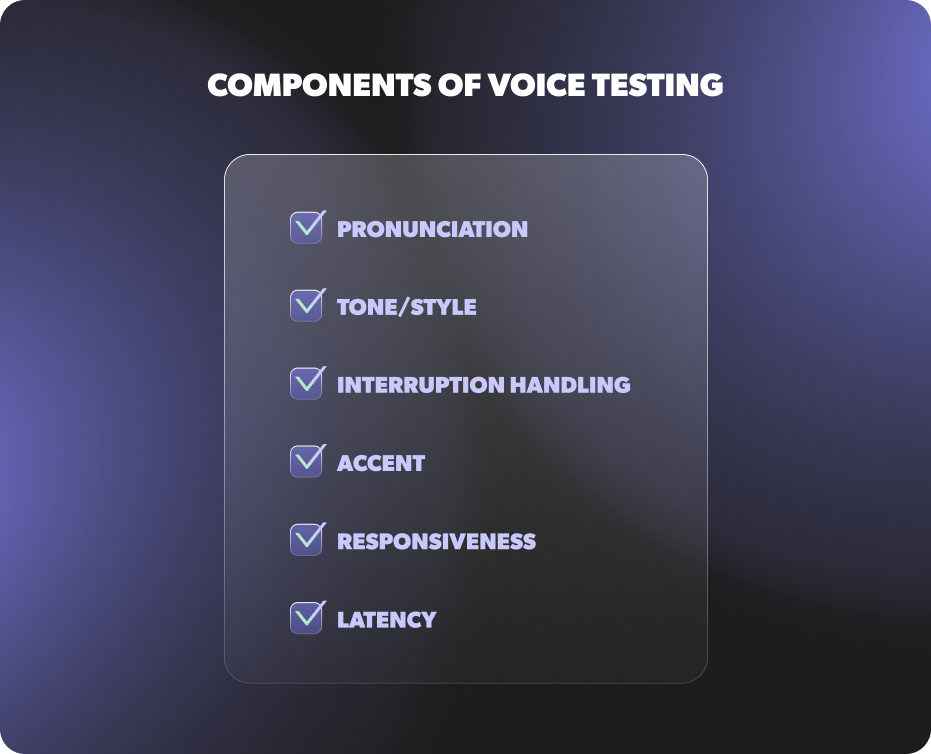
September 2023 Releases
Voice AI is moving fast from pilots to real-world deployments in industries like healthcare, finance, insurance, education, and home services. But running in production is very different from showing well in a demo. Customers don’t follow scripts, they interrupt, they phrase things in unexpected ways. Telephony infrastructure introduces its own risks—dropped calls, failed transfers, lost context. And because AI outputs aren’t deterministic, what works once may not work the next time.
This is what makes true test coverage so difficult. Capturing every phrasing variation, every branch in logic, every voice parameter, and every system handoff isn’t something manual spot checks can handle alone. Comprehensive testing requires structured frameworks designed for enterprise scale and reliability. Without them, small oversights don’t stay small—they ripple into thousands of broken customer experiences.
In this guide, we outline the six testing capabilities you need to deliver consistent, trustworthy customer experiences. When adopting an enterprise-ready voice AI solution, you shouldn’t settle for anything less.
Here are the six testing capabilities every enterprise-ready voice AI platform must deliver.
.png)
Logic is the foundation of any voice agent. If it fails to recognize phrasing, skips steps, or mishandles objections, no amount of polish in voice or telephony will save the experience. Testing must validate multi-turn flows, decision branching, and indirect intent recognition.
Non-negotiables for testing logic:
For example, when a mortgage lender deploys a refinancing agent, one customer might say “I want to refinance my loan,” while another says “My monthly payments are killing me.” Both express the same intent, but a manual testing round could easily validate only the explicit phrasing and miss the indirect one. Without edge-case coverage and regression testing, that gap slips into production, causing qualified leads to be lost. By simulating multi-turn flows and using LLM-based evaluation across paraphrased inputs, the lender can confirm the agent consistently captures refinance intent—no matter how it’s expressed.
Customers form an impression in the first few seconds of audio. Mispronunciations, rushed delivery, or awkward pauses instantly undermine credibility. In regulated industries, clarity and accuracy are not just brand issues—they’re compliance requirements.
Non-negotiables for testing voice:
For example, in healthcare, an eldercare intake agent may need to slow its speech, pause frequently, and use an empathetic tone so older patients can follow along and respond comfortably. At the same time, it must pronounce complex medication names—like metoprolol or hydrochlorothiazide—accurately every time. Without audio playback and configurable TTS settings, the agent might speed up after an update, mispronounce critical drug names, or talk over a patient who responds slowly. What seems like a small voice issue in testing can quickly turn into patient confusion or even a safety risk in production.

Voice agents operate inside larger contact center infrastructure, not in isolation. If telephony flows aren’t tested, failures appear as dropped calls, misrouted transfers, or escalations without context. Customers don’t blame the tech—they blame your brand.
Non-negotiables for testing the telephony stack:
For example, in insurance, when a claims call is escalated, a test should confirm that the transcript and policy details move seamlessly to the human agent. Without this check, the customer is forced to repeat sensitive information, creating frustration and exposing compliance risk. Telephony testing ensures that every transfer is validated before customers experience it.
Manual testing is valuable for reviewing empathy, tone, and phrasing. But no enterprise can rely on manual checks alone; the surface area is too broad and AI outputs are too variable. A hybrid approach ensures both nuance and coverage.
Non-negotiables for testing hybrid coverage:
For example, in education, a student might say “Can I register for Chem 101?” while another asks “Any seats left in Intro to Chemistry?”. Automated simulations confirm both inputs route to the same enrollment workflow, while manual review ensures the agent still sounds supportive and approachable when delivering the response.
Models, prompts, and customer behavior evolve constantly. Without continuous validation, agents degrade quietly until failure spikes force emergency fixes.
Non-negotiables for continuous testing:
In home services, an HVAC agent may suddenly see new seasonal complaints like “my heater is rattling.” Drift detection and regression testing catch this gap early, so retraining closes it before the fallback rate climbs.
.png)
Debugging blind is unacceptable in enterprise environments. When things fail, teams need to see not just what the agent said, but how and why it made each decision. Observability underpins trust, compliance, and accountability.
Non-negotiables for observability:
For example, in finance, an agent might misclassify intent and trigger the wrong function—checking account history instead of processing a loan payoff. With observability in place, the misfire is easy to pinpoint by reviewing the assigned intent, the function invoked, and the payload that was passed, making the root cause clear and actionable.
Any vendor can demo an impressive conversation. The difference between a pilot and a system that truly scales is whether it has testing baked into every layer—logic validation, voice assurance, telephony continuity, hybrid coverage, regression monitoring, and observability.
Regal was built to meet that standard, offering a platform that covers every layer of testing and pairing it with implementation experts who bring proven experience building AI for your industry. If you’re ready to launch voice AI agents that perform reliably in real-world conditions, schedule a demo.

Ready to see Regal in action?
Book a personalized demo.









